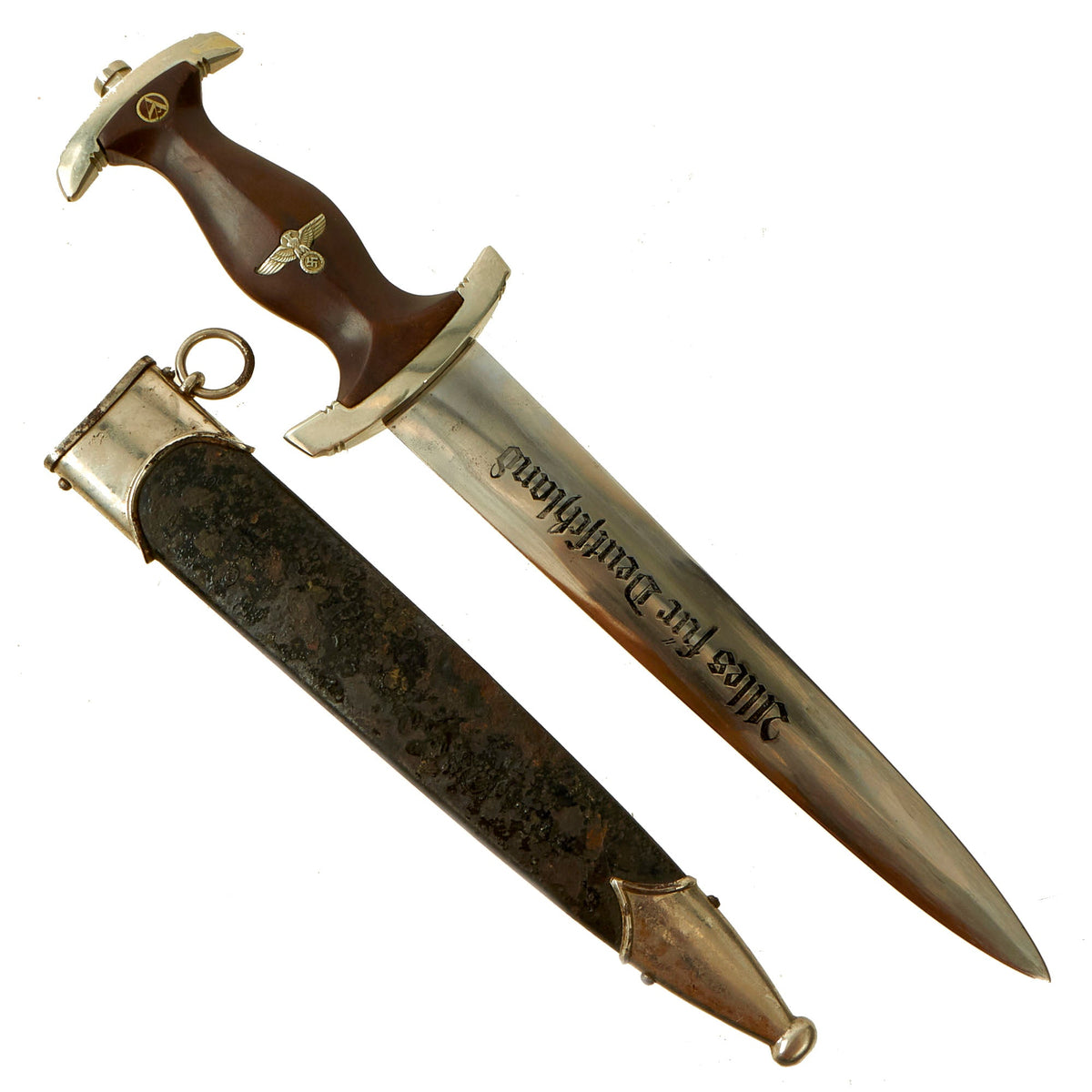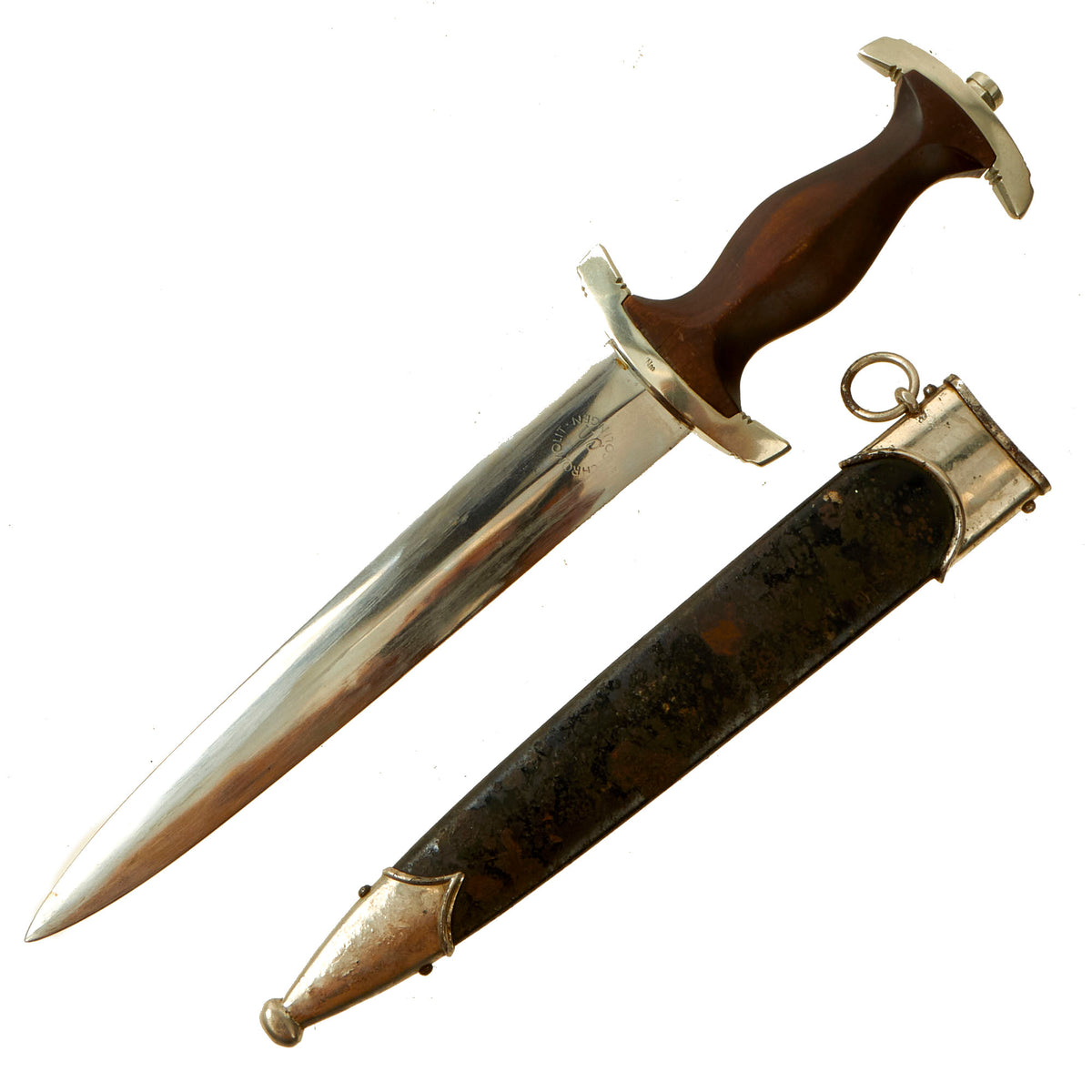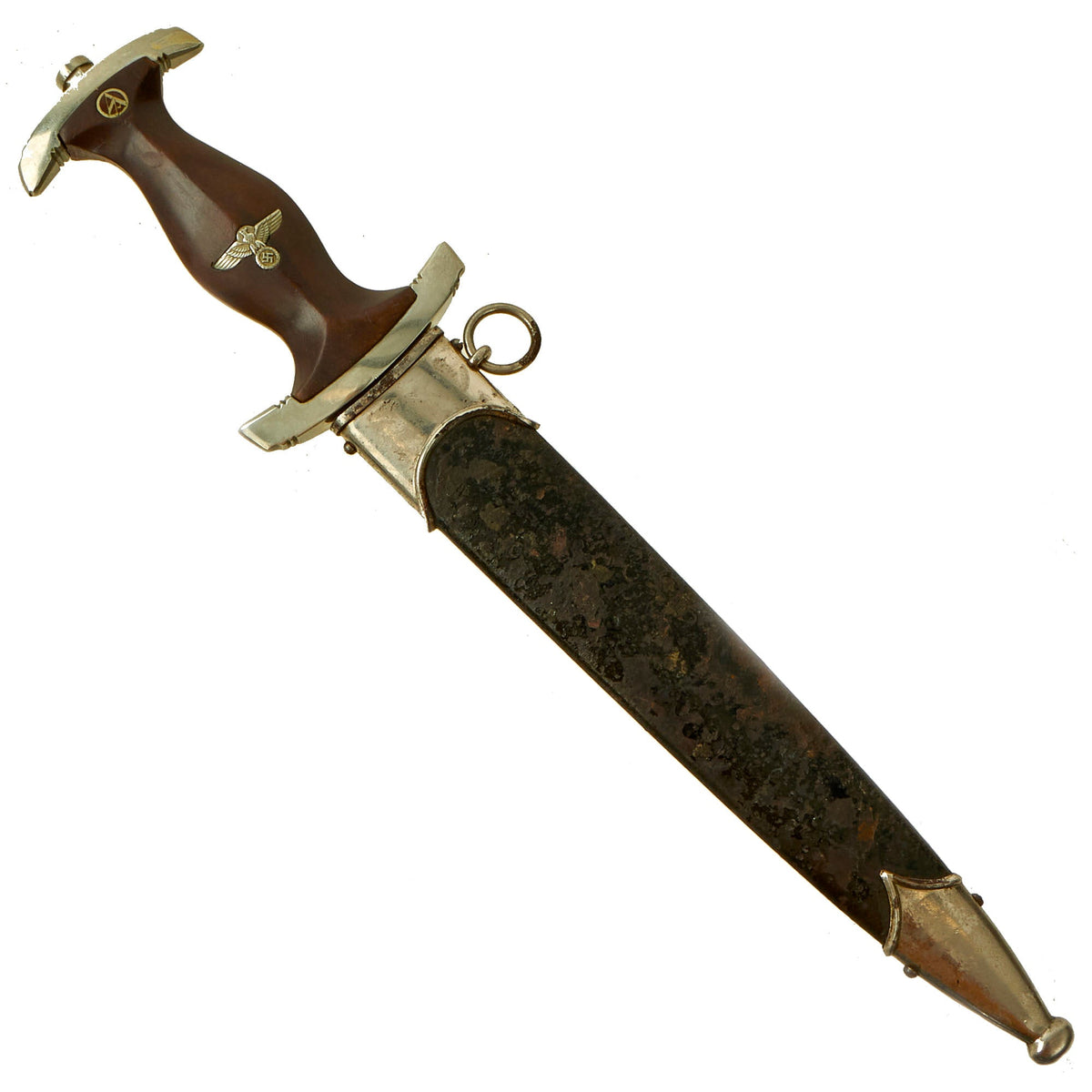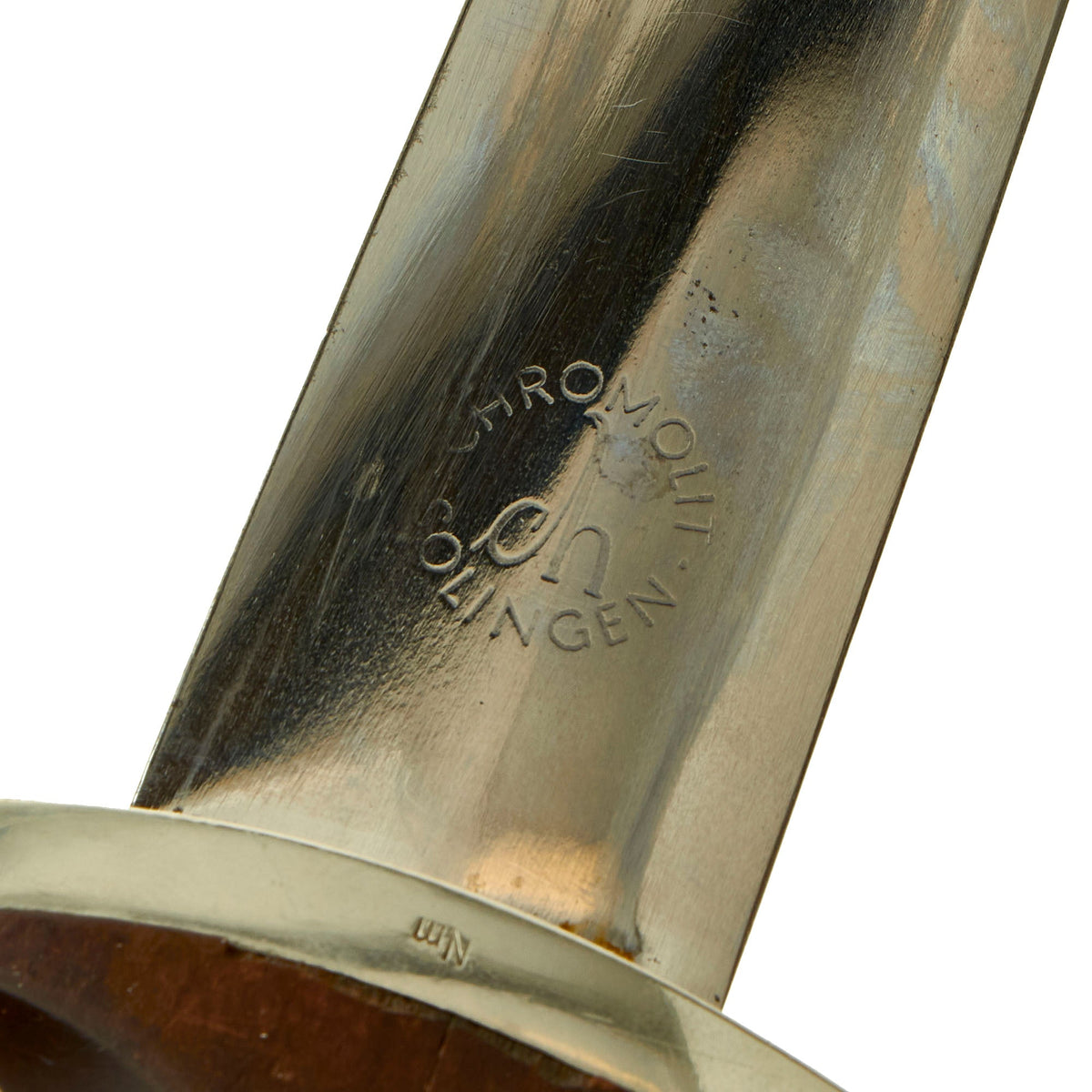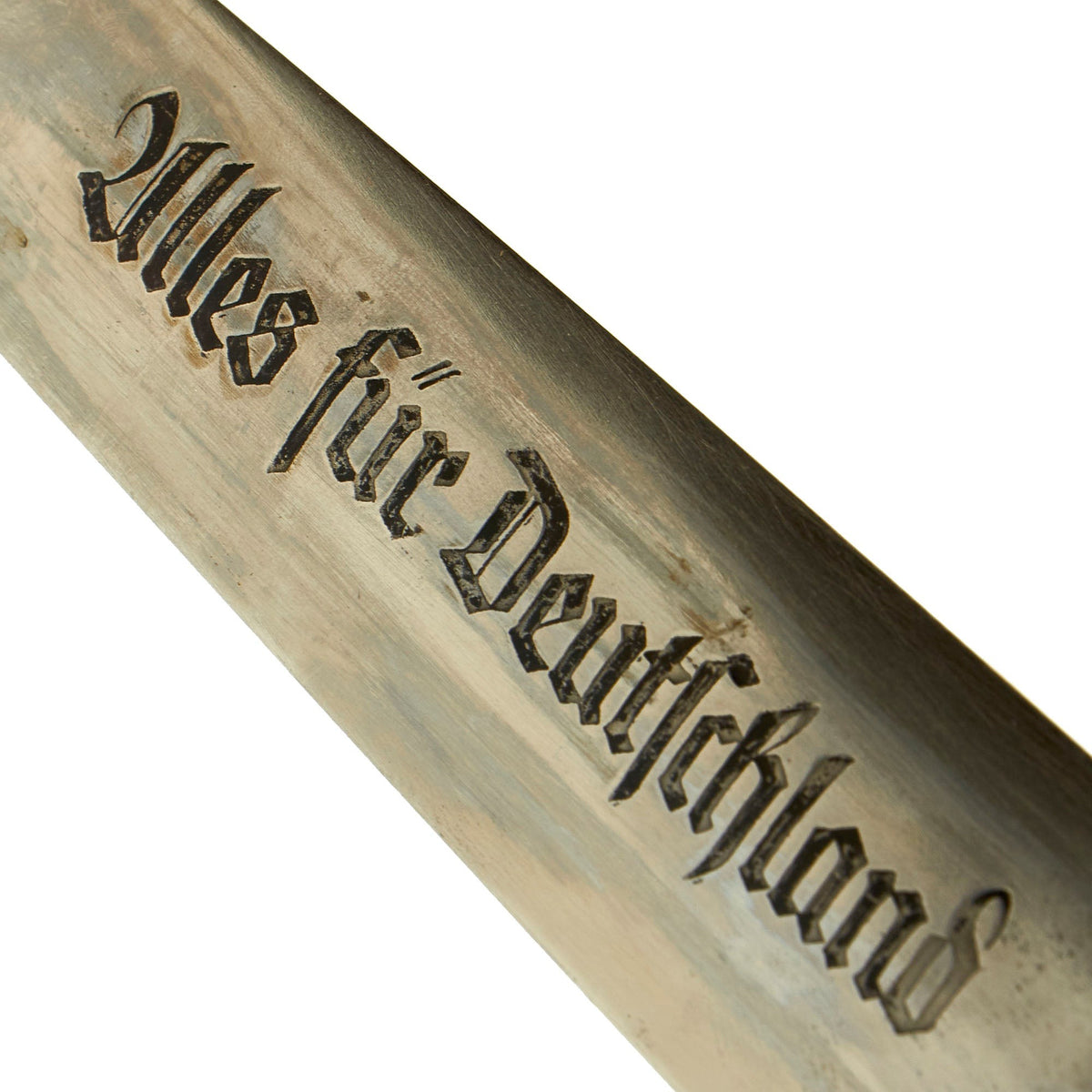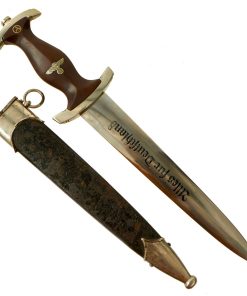Original German Early WWII NSKK Dagger by Rare Maker Arthur Wingen “Chromolit” with Later War Scabbard Original Items
$ 795,00 $ 238,50
Original Item: Only One Available. This is a very good condition early pattern NSKK Dagger, made by the very seldom seen firm of Arthur Wingen “Chromolit”, based in Solingen, Germany. This maker is EXTREMELY rare to find, and this is only the second edged weapon of any type we have had by this firm. It comes comes compete with an original scabbard, which is a later war replacement.
The dagger has solid nickel silver fittings throughout, and is a nice example. The crossguards and tang nut are in very good condition throughout, showing just a bit of oxidation. There is no lifting of any plating, showing that they are indeed solid nickel alloy. They show very little wear or denting, if any, though the tang nut does look to have been tightened a bit without the proper tool, and the grip overall is slightly loose. The lower reverse guard is Gruppe/Gau marked Nm, for Nordmark (Northern Border), which is an area in the far north of Germany contiguous with southern Denmark. The principal city is the port of Kiel on the Baltic Sea, where many of the most important shipbuilders of WWII Germany were located.
The grip is a fine product having a nice deep brownish red color, with medium center ridge construction, and just a bit of wear and a few small dents. This grip is in good condition and fits the crossguards nicely, however there is cracking near both guards. The treatment used on the wood often made it brittle, so cracking is common. The symbol button is still nicely set, and still has most of the translucent enamel intact. The nickel alloy grip eagle is a fine example being the style with beak that points straight. The details are still there to the eagle to include the beak, breast feathering, wing feathering, talons, wreath and mobile swas (hook cross). The nickel finish on both insignia is fully intact, with just a bit of oxidation.
The blade is in very good condition, however it definitely looks to have been cleaned and repolished at some point, which unfortunately has removed nearly all of the factory final polish crossgrain. It also made the maker logo a bit faint as well. It still looks to have the factory edge, which is somewhat sharp, with no signs of post manufacturer sharpening. Many makers left these dull but that was up to the maker. The acid-etched Alles für Deutschland (Everything for Germany) SA motto is slightly worn, and the original factory darkening is mostly worn away, though it was touched up with paint at some point apparently.
Towards the ricasso there is the trademark logo of Arthur Wingen, Chromolit-Besteckfabrik (Chromolite Knife Factory), located in Solingen, Germany, which is clear:
CHROMOLIT
ch
* SOLINGEN *
Per J. Anthony Carter’s book GERMAN KNIFE AND SWORD MAKERS, this firm only produced a few SA / NSKK daggers during the early Third Reich Period. The company was founded by Arthur Wingen, one of Anton Wingen’s three sons, and mainly specialized in chrome-plated cutlery and flatware. They utilized a cursive “ch” trademark both on its own, or with the name and address as well.
The scabbard shell is straight throughout and is the later production style, with a black enameled body and plated steel fittings. Most likely the owner’s original scabbard became damaged, so he got a new one. This one is in good condition, but does show significant rust damage to the steel body as well as the fittings. There is scale rust and erosion, as well as paint loss. The fittings show plating loss and oxidation, especially the lower fitting, which has the plating bubbling up on most of the rear surface. The fittings still have their original screws intact, and the hanger ring is in good condition shape.
An very nice early war NSKK dagger from a very rare maker, complete with an original later scabbard. Ready to display!
Specifications:
Blade Length: 8 3/4″
Overall length: 13 3/4”
Crossguard: 3”
Scabbard Length: 10”
History of the SA-
The SA or Brown Shirts, were a private political formation which Adolf AH and the NSDAP used to maintain order at organized Party meetings and demonstrations. The group was formed in 1921, and grew to a huge force of nearly 3,000,000 men by the later 1930’s. To instill esprit de corps, as well as create employment for the Blade City of Solingen, it was decided each SA man would carry a dagger with his Brown Shirt uniform. Huge quantities needed to be produced to accommodate the demand. The dagger initially was produced of hand-fitted nickel mounts with attractive finished wood grip and brown anodized (a bluing process) finished scabbard.
The blade was etched with the SA motto, Alles für Deutschland. Examples produced prior to 1935 were stamped with the German sector of the SA group on reverse lower crossguard. Later examples underwent standardization through the RZM ministry. These pieces were produced of cheaper plated zinc-base fittings and scabbards were simply painted brown.
Prior to his “unmasking” as a traitor, Ernst Röhm was the leader of the SA. In 1934, he distributed approximately 100,000 SA daggers with his personal inscription on the reverse blade. These daggers were to honor individuals who had served with the SA prior to December, 1931. Other than the inscription, these pieces were identical to the standard M1933 SA dagger. After the Röhm purge, the inscription was ordered to be removed. Many examples were returned to the factory for grinding. Others were simply ground in the field by whatever means were available. Examples will occasionally be encountered with remnants of the original inscription remaining on the blade, but mostly none will remain. Some blades exist with an intact inscription, reflecting only the removal of the Röhm signature. Very very rarely is an example seen with a full, untouched inscription, as the holder would have surely risked a charge of treason.
After the purge, the NSKK, which had been a part of the SA, was split off into a separate organization. They retained the same daggers as the SA, however now used a black painted scabbard, and their officer’s daggers had a few differences as well. Many already had SA daggers, so these had the scabbards painted black over the original brown anodized finish.
Fast Shipping with Professional Packaging
Thanks to our longstanding association with UPS FedEx DHL, and other major international carriers, we are able to provide a range of shipping options. Our warehouse staff is expertly trained and will wrap your products according to our exact and precise specifications. Prior to shipping, your goods will be thoroughly examined and securely secured. We ship to thousands clients each day across multiple countries. This shows how we're dedicated to be the largest retailer on the internet. Warehouses and distribution centres can be located throughout Europe as well as the USA.
Note: Orders with more than one item will be assigned a processing date depending on the item.
Before shipping before shipping, we'll conduct a thorough inspection of the items you have ordered. Today, the majority of orders will be delivered within 48 hours. The delivery time will be between 3-7 days.
Returns
The stock is dynamic and we cannot completely manage it because multiple stakeholders are involved, including our factory and warehouse. So the actual stock may alter at any time. It's possible that you may not receive your order once the order has been made.
Our policy is valid for a period of 30 days. If you don't receive the product within 30 days, we are not able to issue a refund or an exchange.
You can only return an item if it is unused and in the same state as the day you received it. You must have the item in its original packaging.
Related products
Uncategorized
Uncategorized
Uncategorized
Uncategorized
Uncategorized
Uncategorized
Uncategorized
Uncategorized
Uncategorized
Uncategorized
Uncategorized
Uncategorized
Uncategorized
Angolan Rebel 1970s era 60mm Inert Display Mortar from Angolan Civil War Original Items
Uncategorized
Band of Brothers ORIGINAL GERMAN WWII Le. F.H. 18 10.5cm ARTILLERY PIECE Original Items
Uncategorized
Uncategorized
Uncategorized
Uncategorized
Armored Burgonet Helmet & Polearm from Scottish Castle Leith Hall Circa 1700 Original Items
